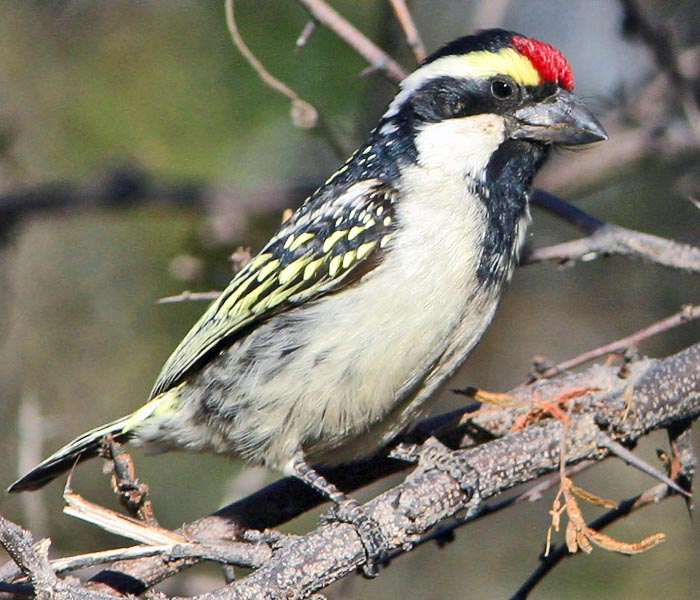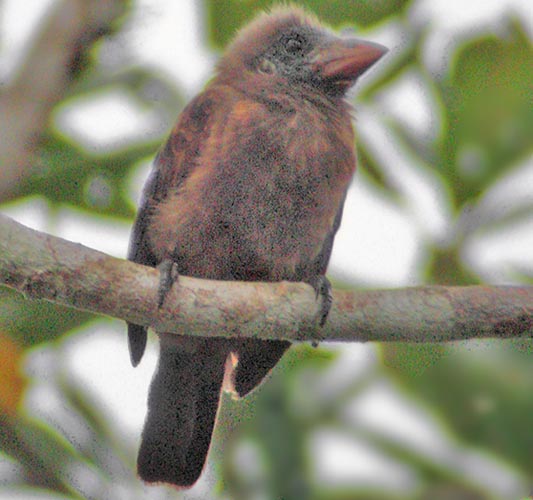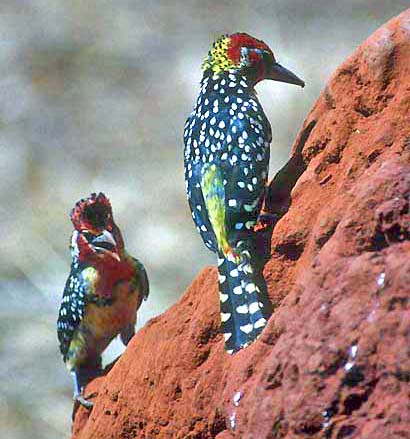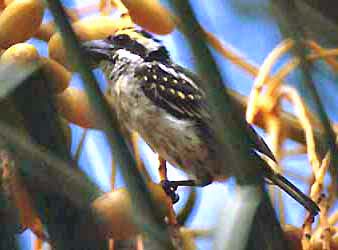| |
a web page by Don Roberson |
AFRICAN BARBETS Lybiidae |
- 43 species in sub-Saharan Africa
- DR personal total: 26 species (60%), 10 photo'd
|
 There
are barbets in the tropics around the world. Barbets in the Old Word
are here treated as two separate families, Asian Barbets [Megalaimidae]
and African Barbets [Lybiidae]. The African barbets are colorful
mid-sized to small birds of African tropics. Some are well-adapted to
the open thornscrub savanna like this Pied Barbet (left). It is a mid-sized barbet in a family that ranges from thimble-sized tinkerbirds to large, gaudy species. There
are barbets in the tropics around the world. Barbets in the Old Word
are here treated as two separate families, Asian Barbets [Megalaimidae]
and African Barbets [Lybiidae]. The African barbets are colorful
mid-sized to small birds of African tropics. Some are well-adapted to
the open thornscrub savanna like this Pied Barbet (left). It is a mid-sized barbet in a family that ranges from thimble-sized tinkerbirds to large, gaudy species.
Just
a couple of decades ago, all barbets around the world were considered
to be in one family, and the Toucans were in a different family.
Molecular studies (Barker & Lanyon 2000, Moyle 2004) have shown
that all the barbets, plus the toucans and toucan-barbets of the New
World, evolved from the same ancestor, and that currently are best
represented by five families: 3 barbets families (New World, Asian,
African) plus toucans and toucan-barbets. |
 An
objection to the Old World arrangement — one family in Asia, the other
in Africa — was posited by Short & Horne (2001, 2002). They pointed
to the dull Gymnobucco barbets of Africa — like Naked-faced Barbet of western Africa (right) — and the Brown Barbet Calorhamphus fuliginosus
of southeast Asia. Both groups are dull-colored, lack the vocal
repertoire of other barbets, and nest colonially. Earlier studies had
suggested that Brown Barbet might be linked to the four species in Gymnobucco. Moyle (2004), however, showed that Gymnobucco
proved to be well within the lineage of African barbets while Brown
Barbet was within the lineage of Asian barbets, and that the
similarities shown were a case of convergent evolution. Short &
Horne (2001) also pointed to earlier cladistic studies (e.g., Prum
1988, Barker & Lanyon 2000) that showed few links between Africa's
ground-dwelling barbets (genus Trachyphonus) and the rest of
the African barbets, and they considered this a "major stumbling block
for those who would recognize three barbet families, one for each
continent." Yet again, Moyle (2004) removed this "stumbling block." He
used three molecular methods and undertook three different types of
analysis, and showed flaws in the early studies. A mis-choice of
analytical methods had the tendency "to unite taxa on long branches
even when not closely related." It appears that the ground-barbets of
Africa are, indeed, related to the other African barbets, and therefore
the entire group evolved on the same lineage from the same ancestor. An
objection to the Old World arrangement — one family in Asia, the other
in Africa — was posited by Short & Horne (2001, 2002). They pointed
to the dull Gymnobucco barbets of Africa — like Naked-faced Barbet of western Africa (right) — and the Brown Barbet Calorhamphus fuliginosus
of southeast Asia. Both groups are dull-colored, lack the vocal
repertoire of other barbets, and nest colonially. Earlier studies had
suggested that Brown Barbet might be linked to the four species in Gymnobucco. Moyle (2004), however, showed that Gymnobucco
proved to be well within the lineage of African barbets while Brown
Barbet was within the lineage of Asian barbets, and that the
similarities shown were a case of convergent evolution. Short &
Horne (2001) also pointed to earlier cladistic studies (e.g., Prum
1988, Barker & Lanyon 2000) that showed few links between Africa's
ground-dwelling barbets (genus Trachyphonus) and the rest of
the African barbets, and they considered this a "major stumbling block
for those who would recognize three barbet families, one for each
continent." Yet again, Moyle (2004) removed this "stumbling block." He
used three molecular methods and undertook three different types of
analysis, and showed flaws in the early studies. A mis-choice of
analytical methods had the tendency "to unite taxa on long branches
even when not closely related." It appears that the ground-barbets of
Africa are, indeed, related to the other African barbets, and therefore
the entire group evolved on the same lineage from the same ancestor. |
 One of those ground barbets is Red-and-yellow Barbet,
which nests and roosts in large termite mounds. The pair (left, nicely
photographed by W. Ed Harper), is working on a such a mound.
Red-and-yellow Barbet is among five species of terrestrial barbets in
Africa in the genus Trachyphonus; this is an old and highly
diverged lineage of barbets. They are the also most insectivorous of
all barbets. Other African barbets are more like their distant
relatives in Asia and South America and are birds of woodlands and
forests, moving erratically in search of fruit. Figs are often favored;
this Red-fronted Barbet (below) is frequenting a fruiting fig tree in east Africa. One of those ground barbets is Red-and-yellow Barbet,
which nests and roosts in large termite mounds. The pair (left, nicely
photographed by W. Ed Harper), is working on a such a mound.
Red-and-yellow Barbet is among five species of terrestrial barbets in
Africa in the genus Trachyphonus; this is an old and highly
diverged lineage of barbets. They are the also most insectivorous of
all barbets. Other African barbets are more like their distant
relatives in Asia and South America and are birds of woodlands and
forests, moving erratically in search of fruit. Figs are often favored;
this Red-fronted Barbet (below) is frequenting a fruiting fig tree in east Africa.

|
| Other African ground-barbets in genus Trachyphonus are Crested Barbet of southern Africa (below left) and D'Arnaud's Barbet
of east Africa (below right). There is substantial variation in plumage
over the range of the latter taxon, and sometimes birds of the southern
population, shown here, are split as a separate species ['Usambiro Barbet']. The Clements checklist continues to the lump them for the moment, awaiting further published studies. |
|
 Some African barbets are particularly gorgeous. The Double-toothed Barbet Lybius bidentatus, local but widespread across the middle of Africa, is one of those; it is deep red below. A close relative is Bearded Barbet,
inhabiting dry, dusky plains of the sahel in west Africa (left). The
male's impressive bristling 'beard,' sticking out from below the bill,
is visible on the upper bird in this backlit photo. Some African barbets are particularly gorgeous. The Double-toothed Barbet Lybius bidentatus, local but widespread across the middle of Africa, is one of those; it is deep red below. A close relative is Bearded Barbet,
inhabiting dry, dusky plains of the sahel in west Africa (left). The
male's impressive bristling 'beard,' sticking out from below the bill,
is visible on the upper bird in this backlit photo.
In contrast to the habitat of Bearded Barbet, Yellow-billed Barbet (below) is a bird of dense undergrowth in thick woodland of west and central Africa.

|
|
All barbets in all three barbet families around the world are
hole-nesters. Those in Asia and the New Word, as well as the African
tinkerbirds, excavate holes in dead trees or stubs. The female Hairy-breasted Barbet
of the west and central African rainforests is shown (above) working at
the potential nest hole. Some African barbets differ in using burrows
in banks or in termite mounds, such as the Red-and-yellow Barbet (as
mentioned above). D'Arnaud's Barbet digs a nearly vertical tunnel in
level ground with a nest chamber at the bottom. Pied Barbet sometimes
uses the deserted nests of swallows.
A different set of African barbets are the ten small tinkerbirds in the genus Pogoniulus.
These are very small tree-top birds, often patterned in
black-and-white, with striped faces and colorful crown patches or
rumps. They are often vocal throughout the day but can be frustratingly
difficult to locate. Their calls are often in the background of films
set in the African scrub or savanna. Among those widespread tinkerbirds
of west and central Africa are (L to R below): Red-rumped Tinkerbird (showing red rump),Yellow-throated Tinkerbird (center), and Yellow-fronted Tinkerbird. |
|
| |
Photos: The Pied Barbet Tricholaema leucomelas was photographed at Waterberg NP, Namibia, in July 2005. The Naked-faced Barbet Gymnobucco calvus was at Antwikwaa, Ghana, on 3 Dec 2013. W. Ed Harper photographed the pair of Red-and-yellow Barbet Trachyphonus erythrocephalus at a termite mound in Tarangire NP, Tanzania, on 4 Aug 1994. The Red-fronted Barbet Tricholaema diademata was eating figs at Lake Baringo, Kenya, 16 Nov 1981. The Crested Barbet Trachyphonus vaillantii was in the Okavango Delta, Botswana, on 27 July 2005. The D'Arnaud's (Usambiro) Barbet T. darnaudii usambiro was at Lake Manyara, Tanzania, in Aug 2002. The Bearded Barbet Pogonornis dubius was in Mole NP, Ghana, on 13 Dec 2013..The Yellow-billed Barbet Pogoniulus bilineatus was in Kakamega forest, Kenya, on 18 Nov 1981. The nest-excavating Hairy-breasted Barbet Tricholaema hirsuta was at Kakum NP, Ghana, on 2 Dec 2013. The Red-rumped Tinkerbird Pogoniulus atroflavus was at Antwikwaa, Ghana, on 3 Dec 2013. The Yellow-throated Tinkerbird P. subsulphureus and the Yellow-fronted Tinkerbird P. chrysoconus were in the Shimba Hills Reserve, Ghana, on 28 Nov 2013. Photos © Don Roberson and W. Ed Harper, used with permission, all rights reserved.
Family Book: Rating: 
Short, L.L., and J.F.M. Horne. 2001. Toucans, Barbets, and Honeyguides. Oxford Univ. Press, Oxford.
I
confess that I don't own this book, nor have I done more that quickly
glance through it in a bookstore. Yet every one of the Oxford
University Press series on bird families has been excellent, and this
looks equally solid. I presume that the "meat" of this book has been
summarized by the same authors in their Handbook of the Birds of the World
series (Short & Horne 2002) which I do own and have studied.
Consistent with Oxford books in this series, the introductory material
is extensive and the species accounts thorough. Plates and
illustrations enliven and enhance the text. If I have any quibble, it
is with the conservative approach to family level taxonomy but, then
again, this was written before the molecular studies by Johansson et
al. (2001) and Moyle (2004).
Literature cited:
- Barker,
F.K., and S.M. Lanyon. 2000. The impact of parsimony weighting schemes
on inferred relationships among toucans and Neotropical barbets (Aves:
Piciformes). Molecular Phylogenetics and Evolution 15: 215-234.
- Burton,
P.J.K. 1984. Anatomy and evolution of the feeding apparatus in the
avian orders Coraciiformes and Piciformes. Bull. Brit. Mus. (Natural
History) 47: 331-441.
- Johansson, U.S., T.J.
Parsons, M. Irestedt, and P.G.P. Ericson. 2001. Clades within "higher
land birds," evaluated by nuclear DNA sequences. J. Zool. Syst. Evol.
Research 39: 37-51
- Lanyon, S.M., and J.G. Hall. 1994. Re-examination of barbet monophyly using mitochondrial-DNA sequence data. Auk 111: 389-397.
- Moyle,
R.G. 2004. Phylogenetics of barbets (Aves: Piciformes) based on nuclear
and mitochondrial DNA sequence data. Mol. Phylog. Evol. 30: 187-200.
- O'Neill, J.P., D.F. Lane, A. W. Kratter, A.P. Capparella, and C.F. Joo. 2000. A striking new species of barbet (Capitoninae: Capito) from the eastern Andes of Peru. Auk 117: 569-577.
- Prum,
R.O. 1988. Phylogenetic interrelationships of the barbets (Aves:
Capitonidae) and toucans (Aves: Ramphastidae) based on morphology with
comparisons to DNA-DNA hybridization. Zool. J. Linnaean Soc. 92:
313-343.
- Short, L.L., and J.F.M. Horne. 2002. Family Capitonidae (Barbets), pp. 140-219 in Del Hoyo, J. Elliott, A., & Sargatal, J. eds. Handbook of the Birds of the World. Lynx Edicions, Barcelona.
- Sibley, C.G., and J.E. Ahlquist. 1990. Phylogeny and Classification of Birds of the World. Yale Univ. Press, New Haven, CT.
|
|
|

